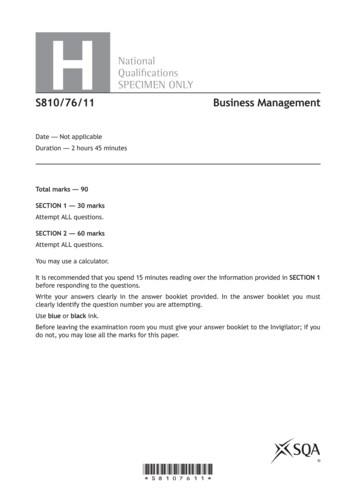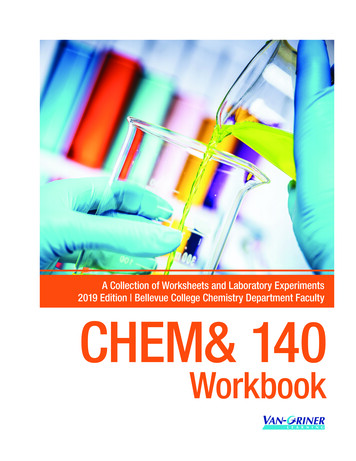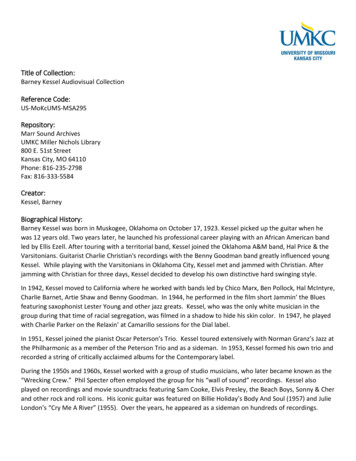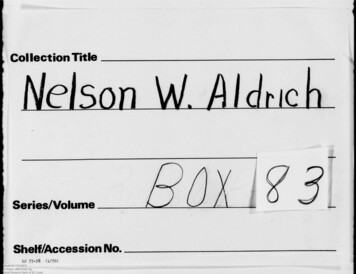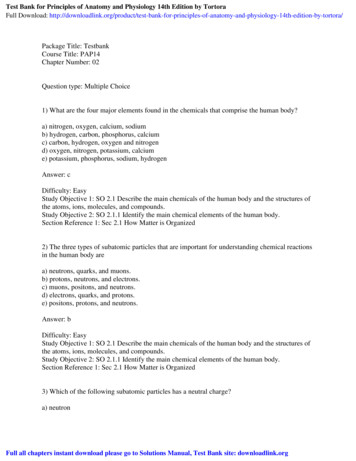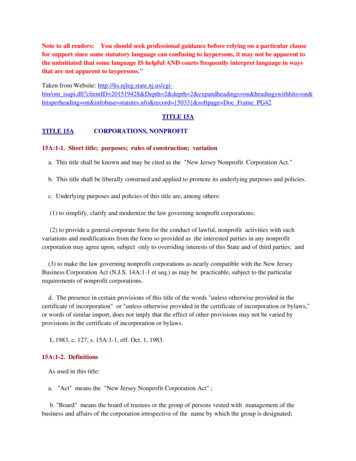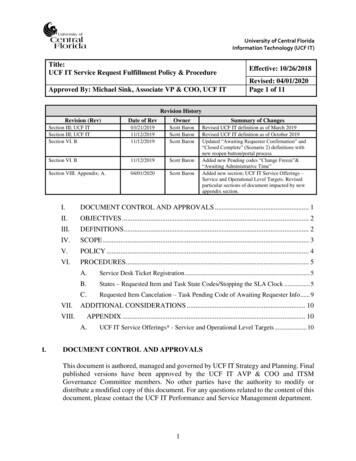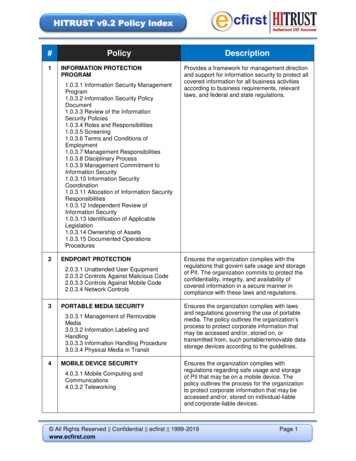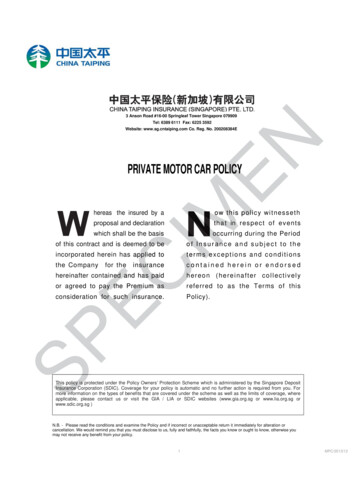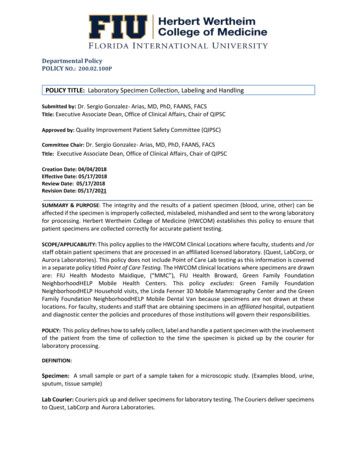
Transcription
Departmental PolicyPOLICY NO.: 200.02.100PPOLICY TITLE: Laboratory Specimen Collection, Labeling and HandlingSubmitted by: Dr. Sergio Gonzalez- Arias, MD, PhD, FAANS, FACSTitle: Executive Associate Dean, Office of Clinical Affairs, Chair of QIPSCApproved by: Quality Improvement Patient Safety Committee (QIPSC)Committee Chair: Dr. Sergio Gonzalez- Arias, MD, PhD, FAANS, FACSTitle: Executive Associate Dean, Office of Clinical Affairs, Chair of QIPSCCreation Date: 04/04/2018Effective Date: 05/17/2018Review Date: 05/17/2018Revision Date: 05/17/2021SUMMARY & PURPOSE: The integrity and the results of a patient specimen (blood, urine, other) can beaffected if the specimen is improperly collected, mislabeled, mishandled and sent to the wrong laboratoryfor processing. Herbert Wertheim College of Medicine (HWCOM) establishes this policy to ensure thatpatient specimens are collected correctly for accurate patient testing.SCOPE/APPLICABILITY: This policy applies to the HWCOM Clinical Locations where faculty, students and /orstaff obtain patient specimens that are processed in an affiliated licensed laboratory. (Quest, LabCorp, orAurora Laboratories). This policy does not include Point of Care Lab testing as this information is coveredin a separate policy titled Point of Care Testing. The HWCOM clinical locations where specimens are drawnare: FIU Health Modesto Maidique, (“MMC”), FIU Health Broward, Green Family FoundationNeighborhoodHELP Mobile Health Centers. This policy excludes: Green Family FoundationNeighborhoodHELP Household visits, the Linda Fenner 3D Mobile Mammography Center and the GreenFamily Foundation NeighborhoodHELP Mobile Dental Van because specimens are not drawn at theselocations. For faculty, students and staff that are obtaining specimens in an affiliated hospital, outpatientand diagnostic center the policies and procedures of those institutions will govern their responsibilities.POLICY: This policy defines how to safely collect, label and handle a patient specimen with the involvementof the patient from the time of collection to the time the specimen is picked up by the courier forlaboratory processing.DEFINITION:Specimen: A small sample or part of a sample taken for a microscopic study. (Examples blood, urine,sputum, tissue sample)Lab Courier: Couriers pick up and deliver specimens for laboratory testing. The Couriers deliver specimensto Quest, LabCorp and Aurora Laboratories.
Patient and Specimen Identification: Correct patient identification is achieved when the healthcareworker is able to confirm the patient’s name, date of birth with the patient, and verify the sameinformation on the specimen label and the requisition with patient involvement.Patient Identifiers: For the purposes of this policy the Patient Identifiers for HWCOM are: (Full name anddate of birth) (Month–Day-Year). Medical record identification number can be utilized as a third patientidentifier if necessary. See HWCOM Administrative Policy: Patient Identifiers No.: 200.02102AActive Communication of asking Patient IdentifiersAsking the patient to tell the healthcare worker their name and date of birth. (Month–Day-Year).Passive Communication of asking Patient IdentifiersThe healthcare worker telling the patient their name and date of birth.National Patient Goal (NPSG): An Industry standard and yearly goal developed to help prevent medicalerrors and maintain quality and patient safety and reduce harm. NPSG goal #1 is correct use of PatientIdentifiers.Misidentification of Specimen: This occurs when a healthcare worker mistakes one patient for anotherby not following correct procedure and use of patient identifiers during specimen collection.Specimen Collection and Required Tubes The Laboratory websites listed below, or the laboratory guidebooks are located in thelaboratory area and assist with the identification of the correct tube, and containers to beutilized for each specimen.The lab where a specimen is processed depends on the type of the specimen and thepatient’s insurance carrier that will cover the cost of that specimen. This applies only topatients that have an insurance carrier.HWCOM Laboratories Three laboratories are utilized at the HWCOM clinical locations: (Quest laboratories, LabCorp and Aurora).Not all HWCOM Clinical locations will utilize the three laboratories.Quest Diagnostics website: www.questdiagnostics.comLabCorp website: www.labcorp.comAurora Diagnostics website: www.auroradx.comClick on Test Menu in each Laboratory website – This menu helps determine the proper tube, containerfor each specimen, and types of tests that are completed at each of these laboratories.EMR Link – www.emr-link.com This site also helps determine the proper tube and container for eachspecimen.PROCEDURE:1.Steps for Specimen Collection: Enter EMR Link listed. Verify the order requested by the physician with the requisition for aMATCH.In EMR Link, print labels and requisition. Print only the number of labels needed for eachspecimen. No extra labels.Policy Title: Laboratory Specimen Collection,Labeling and HandlingPolicy No.: Provided by Risk / QADepartmental PolicyPage 2
Get all necessary equipment to complete the test being ordered (correct tubes, container,gloves, alcohol prep, gauze, Band-Aid)Check expiration dates on all tubes, containers. Discard if expired.Do not pre-label any tubes or specimen containers for safetyAlways Identify yourself to the patient and what tests you will be performingHand wash your hands for at least 20 seconds with soap and water or utilize hand sanitizer.Apply Gloves.Ask the patient the two Patient Identifiers: Patient Name and Date of Birth. (Month, Day,Year)When asking patients their Patient Identifiers use active communication versus passivecommunication. Ask the patient to state his or her full name and date of birth and wait untilthe patient actively tells you his full name and date of birth. Active patient involvement isbest practice.Example: Active Communication: “Can you tell me your name and date of birth?”Example: Passive Communication: “Mr. Smith your date of birth is September 13, 1960.” The patient’s name and date of birth will be checked against the label and the requisition,prior to specimen collection with the involvement of the patient. This ensures properidentification before the procedure begins. A third Patient Identifier can be utilized if there are two patients with the same name. In thiscase, the patient’s Medical Record Identification number can be used. In the Centricity EMR,the Patient ID # serves this purpose. The third identifier is necessary in instances of a patientname alert because two (or more patients) have the same name, names close to beingspelled the same and /or pronounced the same. This third identifier also serves to clarifywhen patient specimens are obtained so that the specimen is properly designated to theright patient. Even if you have drawn specimens on this patient before, you will still utilize the patientidentifiers and check the label and requisition with the patient for a correct Match. Thisassures the patient that this is their specimen and no one else’s. The patient’s room number or physical location is never utilized as a Patient Identifier forspecimens Draw and obtain specimenSpecimen Labeling: Involve the patient in the labeling process. Label the specimen in the presence of the patientafter the specimen has been collected. This assures the patient that this is their specimen.The National Patient Safety Goals (NPSG) set forth yearly as an industry standard emphasizesthe use of Patient Identifiers as National Patient Safety Goal #1 in promoting quality andpatient safety in all levels of patient care. Pre- labeling of specimens is discouraged toprevent labeling errors with wrong patient labels.Minimum label requirements: The label should contain date, time and initials of the staffmember who collected the specimen. This information is vital to the laboratory whoprocesses the specimen because if the specimen is lost they will know when it was collectedand if the specimen is still valid.Policy Title: Laboratory Specimen Collection,Labeling and HandlingPolicy No.: Provided by Risk / QADepartmental PolicyPage 3
Do not collect several patient specimens and then label them all together to save time.Ideally, specimens are labeled as soon as they are collected in the presence of the patientwith patient involvement.Do not print extra labels and keep them in your pockets or drawers as this increases thelikelihood of a mislabeled specimen.Print only the number of labels you will need, no more, no less. You can always go back andprint additional needed labels.Do not begin the next patient until you have completely labeled the specimen and completedall the necessary steps.Specimen Handling: Adhere to universal precautions when handling specimensFollow handling of specimens and storage as directed by the laboratory until specimens aretransported to the laboratory by the courier. example: (room temperature, refrigeration)Ensure all the lids of all specimens are secured tightly and ready for transport when placingin a biohazardous bag.Place the specimen in biohazardous bag that corresponds to the correct lab. The bags arecolor-coded by the laboratories to avoid confusion and errors in sending the specimens tothe wrong laboratory. Biohazardous bags that are orange are for LabCorp, green is for Quest.In addition, Quest has a red biohazardous bag that indicates stat or emergent laboratorytesting. The Aurora laboratory biohazardous bag is blue and white.Place the specimen in the correct Laboratory bin so that the specimen is sent to the correctlaboratory for processing.Remove Gloves, wash handsThe couriers will transport the specimens to the correct laboratory (Quest, LabCorp andAurora)Laboratory Handling:The laboratory must establish positive identification and optimum integrity of a patient's specimen fromreceipt of the specimen through completion of testing and reporting of the results.The laboratory will reject a specimen that is received with any of the following conditions: No label, lacks patient identificationIf the label and the requisition do not matchIncorrect specimen tube, incorrect containerNo date, time, or initials of the staff member obtaining the specimenSpecimen container is cracked or openInsufficient volume to run the specimenIf the laboratory calls with any of the above conditions notify the leader of your location and the provider.Please follow providers recommendations and orders. Complete an incident report. See HWCOMAdministrative Policy: Incident Reporting No.: 200.03.100A.Policy Title: Laboratory Specimen Collection,Labeling and HandlingPolicy No.: Provided by Risk / QADepartmental PolicyPage 4
Safety Precautions for patients and or family members who state they tend to faint at the sight of blood or whenthey have their blood drawn: If the patient appears to be fainting immediately stop phlebotomy procedureInitiate fall precautions so that patient does not fall out of chair and have further injuryIf the patient is in a chair and can respond to your vocal commands have them put their headbetween their legs and breathe slow deep breathsYou can also lower the patient to a lying position and raise feet 8-12 inchesLoosen any tight clothing that may be restricting blood flow (neckties, belts, jacket)Apply cold compresses or washcloth to head and neckUse ammonia inhalants with caution and ensure you know where they are located in case ofan emergencyStay with the patient and do not leave the patient unattendedThe patient should recover fully before being allowed to leaveInstruct patient not to drive for 30 minutes after occurrence for safetyComplete an incident reportFor family members ask them to leave the room during blood collection or at least have themsit downKeep eye contact and verbal communication with both the patient and any of the familymembers during blood collection. Look for signs of fainting, pallor, or decreased responsesto verbal communicationFor any emergency call 911 see HWCOM Administrative Policy: Responding to a MedicalEmergency No.: 200.02.100AInstructions: In the Event an Employee has Eye Exposure with Blood or Other Body FluidsInjured person: Call for help from those nearbyImmediately make your way to the eye wash stationTurn on eyewash or open eyewash bottles and keep flushing both eyes for minimum 15minutesSeek medical attention. Eyewashes are first aid onlyCall 911 if necessaryInstructions: “Hold your eyelids open” while the water flows over each eye“Roll your eyes all around” so the water touches all of the surfaces and gets under the lids“Wash both eyes” even if you think you only contaminated one. Remove contact lenses.“Don’t rub your eyes”Reporting Employee Eye Exposure to Blood or Other Body Fluids: Notify your Director of Operations. Complete an employee injury report:http://hrapps.fiu.edu/injury/ Any questions call HR Employee Injuries Representative, directline 305-348-7960Policy Title: Laboratory Specimen Collection,Labeling and HandlingPolicy No.: Provided by Risk / QADepartmental PolicyPage 5
SUPPORTING/REFERENCE DOCUMENTATION: College of America Pathologist lab General Checklisthttp://www.jointcommission.org/standards information/npsgs.aspx.2017 National Patient Safety Goals Patient IdentifiersQuest Diagnostics Website: www.questdiagnostics.comLabCorp Website: www.labcorp.comAurora Diagnostics Website: www.auroradx.comEmployee Injury Report: d-eye-washstations-where-when-and-how/RELATED POLICIES, PROCEDURES, AND ASSOCIATED FORMS: HWCOM Administrative Policy: Incident Reporting No.: 200.03.100AHWCOM Administrative Policy: Responding to a Medical Emergency No.: 200.02.100AHWCOM Administrative Policy: Patient Identifiers No.: 200.02102APolicy Title: Laboratory Specimen Collection,Labeling and HandlingPolicy No.: Provided by Risk / QADepartmental PolicyPage 6
are: FIU Health Modesto Maidique, (“MMC”), FIU Health Broward, Green Family Foundation NeighborhoodHELP Mobile Health Centers. This . Do not pre-label any tubes or specimen containers for safety Always Identify yourself to the patient and what tests you will be performing
